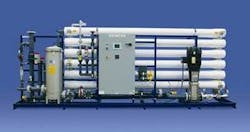by Thomas Muilenberg
Nanofiltration (NF) and Reverse Osmosis (RO) systems are becoming more common in the water industry due to a variety of regulatory and economic factors. NF and RO units are high pressure (90-250 psi or more) membrane-based systems for removing dissolved materials. Unlike microfiltration and ultrafiltration systems, they are not designed for particulate removal. Some common applications for NF and RO include removal of hardness, nitrate, sulfate, total dissolved solids (TDS), heavy metals, radionuclides, organic macromolecules and many other ionic components.
Reasons for using NF and RO generally fall into two categories; the first is that it makes economic or operational sense. A good example is softening. There are many ways to soften, but a nanofiltration system is a simple, one-step process that consistently reduces hardness without lime usage and the sludge production of lime softening or the regeneration of an ion exchange system that produces concentrated brine waste. The second category is that it is simply the only choice. An example of this is nitrate or sulfate reduction. Removal of these components is impossible and/or impractical with a conventional coagulation-filtration process, but simple with NF or RO systems. In addition, other factors such as waste handling can come into play. For example, in radionuclide removal systems, the volume of the waste generated may be greater but in a lower concentration, which may make it easier for a community to dispose of the waste.
Historically, NF and RO systems were expensive enough that they were only adopted in areas where the high cost of land or waste disposal made the economics work. In addition, owners and operators in parts of the country with few systems were unfamiliar with the technology and didn’t fully consider its use. System costs and operating pressures have dropped dramatically over recent years to the point where NF and RO systems can be cost competitive against more conventional options. Changes in water quality regulations have also created a need for technologies that can target certain contaminants. These factors have all motivated the market to embrace these systems in parts of the country, such as the Midwest, that had not traditionally used them.
While there are many reasons to consider NF and RO, some potential owners have concerns about the technology and may be reluctant to use it. Many system designs are adapted from industrial applications, which don’t always meet the needs of the municipal market.
Siemens Water Technologies will introduce the VantageTM M80 series Reverse Osmosis and Nanofiltration systems at the 2007 AWWA Convention and Exposition.
Siemens Water Technologies is introducing the VantageTM M80 series Reverse Osmosis and Nanofiltration systems at the 2007 AWWA Convention and Exposition (ACE). The Vantage M product line is designed with the municipal client in mind, and includes many features and benefits that these customers will appreciate.
The systems are available in 12 standard, factory assembled configurations with permeate flows from 30 to 700 gpm, and are available with nanofiltration, brackish water RO or low pressure RO membranes. The systems are complete with membrane elements, fiberglass reinforced plastic (FRP) ASME code stamped pressure vessels with pressure relief protection, cartridge filter with stainless housing, booster pump, automatic valves and controls, all mounted on a steel frame.
In order to simplify permeate and reject flow settings, the Vantage M has a fully automatic control system. Using a touch screen user interface, the operator simply inputs the desired flow setting and the VFD controlled booster pump takes over to maintain the permeate flow. Recovery is adjusted with a simple hand wheel on the concentrate valve located near the control panel; percent recovery is reported on the operator’s screen. The skid control panels are provided with built-in connectivity so they can be integrated with the overall plant controls.
A full suite of instrumentation is included with the systems. Continuous monitoring of pH, oxidation reduction potential (ORP), temperature, conductivity, percent salt rejection (%), and flows are standard features, so performance can be monitored and protected from upset conditions in the feed water.
The system is started up by activating the virtual “start” button on the touch screen, and the skids automatically go through a pre-service flush, much like a filter-to-waste cycle on a conventional media filter, until the permeate quality is up to specifications. Once the permeate meets quality, the system automatically switches back to providing finished water.
Another convenient feature on larger systems is a built-in raw water blend line, making it easy to dial in desired finished water quality, such as in softening applications.
Overnight shutdowns require that the concentrate side of the membrane be flushed so that the concentrated water does not precipitate out the foulants when the system is shut down. The ability to perform this flush has traditionally been an optional add-on feature, and was often a manually controlled option. The Vantage M is supplied with automatic feed side flush that engages any time the system is stopped. In addition, automatic periodic standby flushing can be selected through the operator interface in case of extended shutdowns.
A common concern has been that many of the industrial based systems do not meet the materials requirements of the municipal market. The Vantage M uses NSF approved materials for the membrane elements, ASME code pressure vessels, stainless steel high pressure piping and schedule 80 PVC low pressure piping. The painted steel skid fully extends past the end piping, and helps guard against accidental breakage of auxiliary piping during shipping and skid installation.
The volume of waste produced by NF and RO systems continues to be an issue in some communities, as they do generate a relatively high amount of waste. Recovery, the percentage of permeate produced relative to the raw water fed to the system, is 75% on average for a single-pass system. Depending on water quality, this can be adjusted up or down somewhat. Another option that is gaining in popularity is to treat the waste concentrate from a set of primary skids using a secondary RO system. Since the system is only used to treat the waste from the primary systems, it is, of course, a smaller skid. The Vantage M design can be used for this application as well. One advantage of using a recovery skid is that this skid can be optimized for the treatment of the higher TDS waste. For example, different membranes can be chosen that are more suited to the concentrated water. Also, the recovery can be optimized for the waste stream. In some cases, the overall system recovery can be raised from 75% to about 90%, depending on water quality, through the use of a recovery skid.
Inadequate pretreatment is one of the primary causes of NF and RO system operational problems. To complement the Vantage M series, Siemens Water Technologies offers many pretreatment products. Conventional clarification and filtration, and pre-engineered multi-barrier systems such as the Memcor XP and XS, are just a few examples. Siemens will select the most cost-effective and robust pretreatment system based on specific needs. For long-term support, the company also offers service packages that can include chemical cleaning, membrane inspection, testing, general servicing and reviewing of records to optimize long-term performance.
About the Author:
Thomas Muilenberg is a Technical Sales Manager for the General Filter and Microfloc brand of products at Siemens Water Technologies. He has been with the company since 1993, and is located in Ames, IA. Contact: 515-268-8559 or [email protected].



